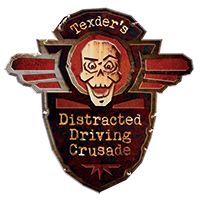Mission and Purpose
We’ve all done it. Driving along, the cell phone beeps, and we reach down to grab it and send a quick text. Or we start making lane changes with one hand on the wheel and the other keeping the phone plastered to our ear. Even simple tasks like drinking a beverage or fiddling with the radio can distract us from our primary task — driving. Heck, sometimes our own daydreaming is a distraction!
In this time-crunched, multitasking world, we try to squeeze as much as we can into every activity. The problem is, distracted driving is incredibly dangerous, both to us and those around us. We’ve all heard the horror stories. Good people have died, and good people have killed because of distracted driving. Chances are you know someone who has been personally affected by distracted driving. But have you changed your behavior? Why not?
Most of us have a certain amount of “that will never happen to me” mentality. We all feel varying degrees of invincibility — especially the younger among us. Preaching doesn’t work. Scare tactics don’t work. Companies like AT&T have been telling us for years how dangerous distracted driving is with campaigns like #ItCanWait. They’ve produced beautifully gut-wrenching videos like this one to drive the point home:
We see these, and we are impacted briefly. But soon, we are back to our old ways, doing the same dangerous things. Why? For one, research shows that scare tactics don’t have a lasting impact, and can sometimes even have the opposite effect from what is intended. So videos like these or parking a smashed up car outside of a school is not having the desired impact on changing behavior.
Behavior changes happen over time, as a result of regular and consistent messaging. That’s why we’ve created video lessons that address the top 10 distracted driving activities. A life-size hot rod pledge car is a not-so-subtle reminder of your commitment to change bad habits. Texder and his crew are there every day with a new lesson reminder. Yes, you’ll be entertained. But you’ll also remember the lessons and your pledge the next time you get behind the wheel.
Statistics
At any given daylight moment across America, approximately 660,000 drivers are using cell phones or manipulating electronic devices while driving
10% of drivers of all ages under the age of 20 involved in fatal crashes were reported as distracted at the time of the crash. This age group has the largest proportion of drivers who were distracted.
Drivers in their 20s make up 27 percent of the distracted drivers in fatal crashes.
20 percent of teens and 10 percent of parents admit that they have extended, multi-message text conversations while driving.
Business and Financial Impact
Motor vehicle crashes cost employers $60 billion annually in medical care, legal expenses, property damage, and lost productivity. They drive up the cost of benefits such as workers’ compensation, Social Security, and private health and disability insurance. In addition, they increase the company overhead involved in administering these programs.
The average crash costs an employer $16,500. When a worker has an on-the-job crash that results in an injury, the cost to their employer is $74,000. Costs can exceed $500,000 when a fatality is involved.
Research
Research articles from Distraction.gov
Psychology & Marketing, Vol. 21(11): 961–986 (November 2004). Fear Appeals in Social Marketing: Strategic and Ethical Reasons for Concern Gerard Hastings and Martine Stead, University of Stirling & Open University; John Webb, University of Strathclyde
NHTSA [2003]. The economic burden of traffic crashes on employers: costs by state and industry and by alcohol and restraint use. Publication DOT HS 809 682.
